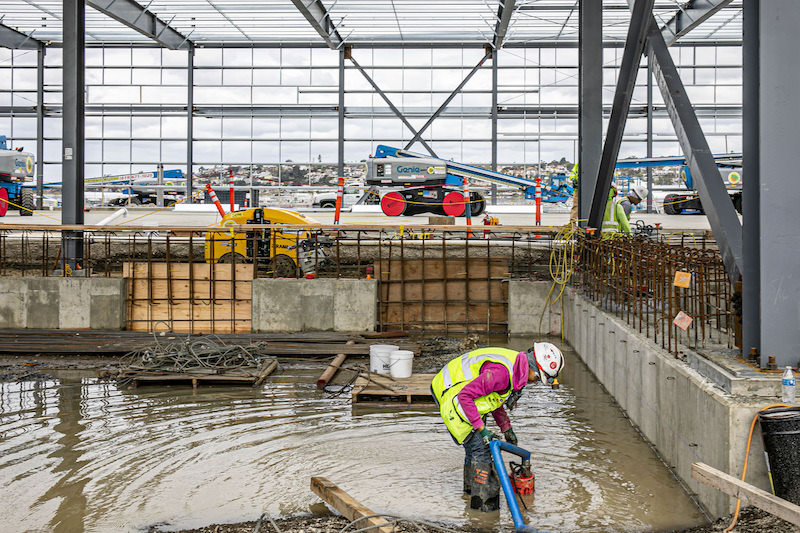Nonresidential construction spending in April declined for the fifth-straight month to a two-year low as demand waned for numerous public and private project categories in the face of lengthening production and delivery times for materials, along with fast-rising prices for many items, according to an analysis of new federal construction spending data by the Associated General Contractors of America. Officials with the association urged the President and Congress to boost infrastructure investments, remove tariffs on key materials and take steps to address production and deliver backups for key construction supplies.
“Both public and private nonresidential spending overall continued to shrink in April, despite a pickup in a few spending categories from March,” said Ken Simonson, the association’s chief economist. “Ever-growing delays and uncertainty regarding backlogs and delivery times for key materials, as well as shortages and record prices, are likely to make even more project owners hesitant to commit to new work.”
Construction spending in April totaled $1.52 trillion at a seasonally adjusted annual rate, an increase of 0.2% from the pace in March and 9.8% higher than the pandemic-depressed rate in April 2020. As has been true for the past several months, the year-over-year gain was limited to residential construction, Simonson noted. That segment climbed 1.0% for the month and 29.5% year-over-year. Meanwhile, combined private and public nonresidential spending declined 0.5% from March—the fifth consecutive monthly decrease—and 3.9% over 12 months, to the lowest annual rate since December 2018.
Private nonresidential construction spending fell 0.5% from March to April and 4.8% since April 2020, with year-over-year decreases in 10 out of 11 subsegments. The largest private nonresidential category, power construction, plunged 7.1% year-over-year and 1.8% from March to April. Among the other large private nonresidential project types, commercial construction—comprising retail, warehouse and farm structures—retreated 1.3% year-over-year despite a gain of 0.4% for the month. Manufacturing construction rose 0.6% from a year earlier and 0.4% from March. Office construction decreased 1.6 percent year-over-year but edged up 0.2 percent in April.
Public construction spending slipped 2.2% year-over-year and 0.6% for the month. Among the largest segments, highway and street construction declined 2.7% from a year earlier, although spending rose 0.6% for the month. Public educational construction decreased 4.0% year-over-year and 0.5% in April. Spending on transportation facilities fell1.9% over 12 months and 1.2% in April.
Association officials cautioned that a recent Commerce Department announcement that it intends to double the current tariff levels on Canadian lumber would further undermine nonresidential construction activity. They said the Biden administration should instead remove tariffs on lumber, steel and aluminum and work to ease production and shipping delays. Boosting infrastructure funding, which leaders of both parties have proposed, will also help, the construction officials added.
“The last thing construction workers need is for the Biden administration to double tariffs on lumber,” said Stephen E. Sandherr, the association’s chief executive officer. “Instead of making it even harder to build, the administration needs to ease supply backups, remove tariffs and pass a bipartisan infrastructure bill.”
Related Stories
Industry Research | Dec 28, 2022
Following a strong year, design and construction firms view 2023 cautiously
The economy and inflation are the biggest concerns for U.S. architecture, construction, and engineering firms in 2023, according to a recent survey of AEC professionals by the editors of Building Design+Construction.
Self-Storage Facilities | Dec 16, 2022
Self-storage development booms in high multifamily construction areas
A 2022 RentCafe analysis finds that self-storage units swelled in conjunction with metros’ growth in apartment complexes.
Market Data | Dec 13, 2022
Contractors' backlog of work reaches three-year high
U.S. construction firms have, on average, 9.2 months of work in the pipeline, according to ABC's latest Construction Backlog Indicator.
Contractors | Dec 6, 2022
Slow payments cost the construction industry $208 billion in 2022
The cost of floating payments for wages and invoices represents $208 billion in excess cost to the construction industry, a 53% increase from 2021, according to a survey by Rabbet, a provider of construction finance software.
Mass Timber | Dec 1, 2022
Cross laminated timber market forecast to more than triple by end of decade
Cross laminated timber (CLT) is gaining acceptance as an eco-friendly building material, a trend that will propel its growth through the end of the 2020s. The CLT market is projected to more than triple from $1.11 billion in 2021 to $3.72 billion by 2030, according to a report from Polaris Market Research.
Market Data | Nov 15, 2022
Construction demand will be a double-edged sword in 2023
Skanska’s latest forecast sees shorter lead times and receding inflation, but the industry isn’t out of the woods yet.
Reconstruction & Renovation | Nov 8, 2022
Renovation work outpaces new construction for first time in two decades
Renovations of older buildings in U.S. cities recently hit a record high as reflected in architecture firm billings, according to the American Institute of Architects (AIA).
Market Data | Nov 3, 2022
Building material prices have become the calm in America’s economic storm
Linesight’s latest quarterly report predicts stability (mostly) through the first half of 2023
Building Team | Nov 1, 2022
Nonresidential construction spending increases slightly in September, says ABC
National nonresidential construction spending was up by 0.5% in September, according to an Associated Builders and Contractors analysis of data published today by the U.S. Census Bureau.
Hotel Facilities | Oct 31, 2022
These three hoteliers make up two-thirds of all new hotel development in the U.S.
With a combined 3,523 projects and 400,490 rooms in the pipeline, Marriott, Hilton, and InterContinental dominate the U.S. hotel construction sector.

















